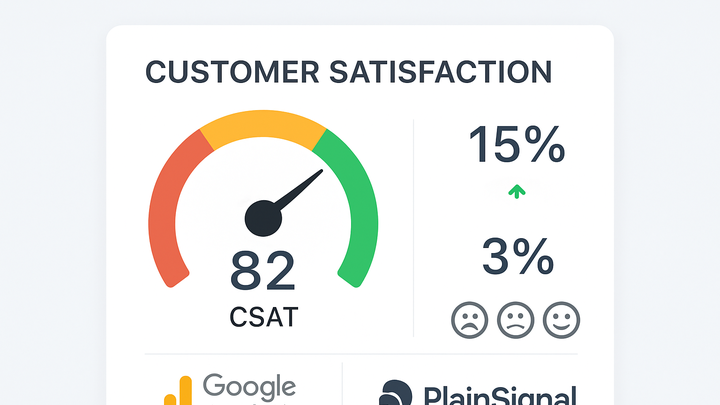Published on 2025-06-28T06:13:37Z
What is Customer Satisfaction Score (CSAT)? Examples and Best Practices
Customer Satisfaction Score (CSAT) is a metric in analytics that measures the percentage of customers who are satisfied with a company’s products or services. CSAT surveys typically ask respondents to rate their experience on a scale (e.g., 1 to 5). The final CSAT score represents the proportion of positive ratings and is presented as a percentage. A high CSAT indicates strong customer approval, correlating with loyalty and retention. Surveys are often triggered after key touchpoints (like purchases, support interactions, or feature usage) to gather timely feedback.
Key benefits of CSAT:
- Fast feedback on specific interactions.
- Simple calculation and interpretation.
- Provides actionable insights for improvement.
When integrated with analytics platforms like GA4 and cookie-free PlainSignal, CSAT data can be correlated with user behavior for deeper analysis. For a holistic view, combine CSAT with other metrics such as NPS and CES.
Customer satisfaction score (csat)
CSAT quantifies customer satisfaction as a percentage from survey responses, vital for analytics and integrates with tools like GA4 and PlainSignal.
Overview of CSAT
Customer Satisfaction Score (CSAT) is a key metric in analytics that measures how satisfied customers are with a company’s products or services. It is collected via short surveys and expressed as a percentage. Higher CSAT values correlate with loyalty, retention, and positive referrals. Organizations use CSAT to gauge the effectiveness of interactions like purchases, support tickets, or feature usage. By understanding customer satisfaction at various touchpoints, businesses can prioritize improvements and allocate resources more effectively.
-
Definition
CSAT represents the proportion of customers who report a positive experience based on survey ratings.
-
Purpose
Tracks customer happiness in real time, allowing teams to respond quickly to issues and validate improvements.
Calculating CSAT
Accurate calculation of CSAT ensures meaningful insights. This section breaks down the formula and how to interpret the resulting percentage.
-
Csat formula
Formula:
(Satisfied customers / Total responses) × 100
Where ‘satisfied’ typically counts ratings of 4 or 5 on a 5-point scale.
-
Interpreting scores
A higher CSAT percentage indicates greater overall satisfaction. Industry benchmarks vary, but scores above 80% are often considered strong. Track trends over time rather than isolated values to identify improvements or emerging issues.
Implementing CSAT Surveys
The success of CSAT measurement hinges on well-crafted surveys and strategic distribution. Design questions and choose channels that maximize response rate and data quality.
-
Question design
Use clear, unbiased questions like ‘How satisfied are you with your experience today?’ and stick to a consistent rating scale (e.g., 1–5).
-
Distribution channels
Leverage multiple touchpoints to reach customers effectively:
-
On-site popups
Trigger pop-up surveys after key actions such as checkout completion or ticket resolution.
-
Email surveys
Send follow-up emails with embedded links to the survey shortly after the interaction.
-
In-app prompts
Ask for feedback within mobile or web applications right after feature use or session completion.
-
Tracking CSAT with Analytics Tools
Integrate CSAT data into analytics platforms to correlate satisfaction with user behavior and site performance.
-
Google analytics 4 (GA4)
Send CSAT survey submissions as custom events to GA4 using
gtagoranalytics.js. Define these events as conversions to monitor satisfaction trends alongside other key metrics. -
PlainSignal (cookie-free analytics)
PlainSignal offers lightweight, privacy-first analytics suitable for tracking CSAT without cookies.
-
Integration code
Include the following snippet on your site to load PlainSignal:
<link rel="preconnect" href="//eu.plainsignal.com/" crossorigin /> <script defer data-do="yourwebsitedomain.com" data-id="0GQV1xmtzQQ" data-api="//eu.plainsignal.com" src="//cdn.plainsignal.com/plainsignal-min.js"></script>Then use PlainSignal’s event API to record CSAT survey responses.
-
Best Practices and Limitations
CSAT is powerful but not foolproof. Combine it with other metrics and remain aware of potential biases to get a complete view of customer experience.
-
Combining metrics
Use CSAT alongside Net Promoter Score (NPS) and Customer Effort Score (CES) for a fuller picture of customer sentiment.
-
Addressing bias and sample size
Response bias can occur if only extremely satisfied or dissatisfied customers participate. Aim for a representative sample and simplify survey steps to improve participation rates.
-
Cultural considerations
Interpret rating scales in context—different regions may use rating scales differently. Localize surveys and analyze results with cultural norms in mind.
